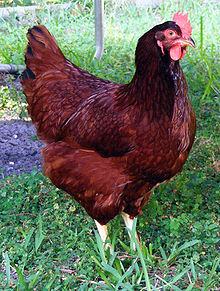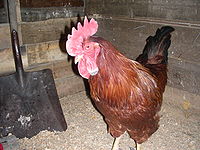Rhode Island Red: Difference between revisions
Johnny Pez (talk | contribs) |
|||
| Line 34: | Line 34: | ||
Developed in Rhode Island & Massachusetts, early flocks often had both single and rose combed individuals because of the influence of Malay blood. It was from the [[Malay (chicken)|Malay]] that the Rhode Island Red got its deep color, strong constitution, and relatively hard feathers.<ref>http://www.ansi.okstate.edu/breeds/poultry/chickens/rhodeislandred/</ref> |
Developed in Rhode Island & Massachusetts, early flocks often had both single and rose combed individuals because of the influence of Malay blood. It was from the [[Malay (chicken)|Malay]] that the Rhode Island Red got its deep color, strong constitution, and relatively hard feathers.<ref>http://www.ansi.okstate.edu/breeds/poultry/chickens/rhodeislandred/</ref> |
||
The Rhode Island Red were originally bred in [[Adamsville, Rhode Island|Adamsville]], a village which is part of [[Little Compton, Rhode Island|Little |
The Rhode Island Red were originally bred in [[Adamsville, Rhode Island|Adamsville]], a village which is part of [[Little Compton, Rhode Island|Little Compton]], [[Rhode Island]]. One of the foundation sires of the breed was a black-breasted red [[Malay (chicken)|Malay]] cock which was imported from England. This cock is on display at the Smithsonian Institution as the father of the Rhode Island Red breed.{{Citation needed|date=October 2009}} |
||
In 1925, the Rhode Island Red Club of America donated funds for [[Rhode Island Red (sculpture)|an elegant monument]] to the Rhode Island Red in Adamsville, near the baseball field and across the street from what used to be Abraham Manchester's restaurant. (The monument is now on the [[National Register of Historic Places]].) A competing monument to the Rhode Island Red, claiming its creation not for the poultry fanciers, but for the farmers who grew them commercially in great numbers in Little Compton, was erected by the state in 1954 a mile or so (about two kilometers) south of Adamsville.{{Clarify|date=October 2009}}{{Citation needed|date=October 2009}} |
In 1925, the Rhode Island Red Club of America donated funds for [[Rhode Island Red (sculpture)|an elegant monument]] to the Rhode Island Red in Adamsville, near the baseball field and across the street from what used to be Abraham Manchester's restaurant. (The monument is now on the [[National Register of Historic Places]].) A competing monument to the Rhode Island Red, claiming its creation not for the poultry fanciers, but for the farmers who grew them commercially in great numbers in Little Compton, was erected by the state in 1954 a mile or so (about two kilometers) south of Adamsville.{{Clarify|date=October 2009}}{{Citation needed|date=October 2009}} |
||
Revision as of 06:26, 14 November 2011
This article needs additional citations for verification. (October 2009) |
 A Rhode Island Red Hen | |
| Conservation status | Recovering |
|---|---|
| Other names | Rhode Islands |
| Nicknames | RIR |
| Country of origin | USA |
| Traits | |
| Weight |
|
| Skin color | Yellow |
| Egg color | Brown |
| Comb type | Single |
| Classification | |
| APA | Recognized by the APA |
| Notes | |
| Dual purpose layer breed | |
| |

The Rhode Island Red is a breed of chicken (Gallus gallus domesticus). They are a utility bird, raised for meat and eggs, and also as show birds. They are a popular choice for backyard flocks because of their egg laying abilities and hardiness. Non-industrial strains of the Rhode Island Red are listed as recovering by the American Livestock Breeds Conservancy.[1] Three vital variations appeared to have had the largest impact around the Rhode Island Red: Asiatics, Game, and Mediterranean.[2]
The Rhode Island Red is the state bird of Rhode Island.[3]
Appearance
The bird's feathers are rust-colored, but darker shades are known, including maroon bordering on black. Their eyes are red-orange and they have yellow feet, with reddish-brown beaks. Chicks are a light red to tan color with two dark brown bars running down their backs. The Roosters usually weigh in at 8.5 pounds (3.9 kg), the Hens slightly less at 6.5 pounds (2.9 kg), cockerel at 7.5 pounds (3.4 kg), and pullets at 5.5 pounds (2.5 kg).[4]
History
Developed in Rhode Island & Massachusetts, early flocks often had both single and rose combed individuals because of the influence of Malay blood. It was from the Malay that the Rhode Island Red got its deep color, strong constitution, and relatively hard feathers.[5]
The Rhode Island Red were originally bred in Adamsville, a village which is part of Little Compton, Rhode Island. One of the foundation sires of the breed was a black-breasted red Malay cock which was imported from England. This cock is on display at the Smithsonian Institution as the father of the Rhode Island Red breed.[citation needed]
In 1925, the Rhode Island Red Club of America donated funds for an elegant monument to the Rhode Island Red in Adamsville, near the baseball field and across the street from what used to be Abraham Manchester's restaurant. (The monument is now on the National Register of Historic Places.) A competing monument to the Rhode Island Red, claiming its creation not for the poultry fanciers, but for the farmers who grew them commercially in great numbers in Little Compton, was erected by the state in 1954 a mile or so (about two kilometers) south of Adamsville.[clarification needed][citation needed]
Rhode Island Reds and Sussex are also used for many modern hybrid breeds. Many modern hybrid hens have Rhode Island Red fathers, mainly due to the prolific egg laying characteristic of the Rhode Island Red, which is passed down through the males.[citation needed] Rhode Island Reds cocks were hybridised with Black Shumen chicken and Starozagorska red chicken.[6] [7]
Characteristics
The Reds are friendly chickens with a good nature. They are good pets for children, but they can get aggressive when annoyed (especially roosters).[citation needed]

Rhode Island Reds are tough birds, resistant to illness, good at foraging and free ranging, and typically docile, quiet, and friendly. Although they are widely known as good layers through cold periods, if the coop temperature drops below freezing (0 °C (32 °F)), their output drops considerably, and the tips of their combs become very susceptible to frostbite.[citation needed]
Although usually friendly, Rhode Island Red roosters, and sometimes hens, can be quite aggressive towards young children and adults. Most roosters will also attack strangers (humans or animals) if they feel nervous or have never seen the intruder. They are usually friendlier with familiar people, such as those responsible for feeding. Both hens and roosters are known to be aggressive with other chickens, especially in confinement.[citation needed]Rhode Island Red roosters have been known to kill intruding foxes or dogs.[citation needed]
Even though they can have an aggressive nature, if raised properly and lovingly, they can be very loving, even affectionate. They will come when called or when they can see their owner and will walk with him/her just as a dog would. Rhode Island Reds and their hybrid descendants will happily sit on their owners laps, arms or even shoulders. These chickens care for each other as well, and often stay in a group.
Eggs
Frequent layers, Rhode Island Reds are noted for their brown eggs. Although they can sometimes be stubborn, they can end up producing up to 200 eggs a year but a healthy one can lay more. When free ranged, their first year eggs can be too large to fit comfortably in standard or medium egg cartons. Healthy hens can lay up to 6-7 eggs per week depending on their care and treatment. Rhode Island Red hens lay many more eggs than an average hen if provided plenty of quality feed.[citation needed]
References
- ^ http://www.ansi.okstate.edu/breeds/poultry/chickens/rhodeislandred/index.htm
- ^ http://rhodeislandredchickens.net/rhode-island-red-chickens-traditions-poultry-types-2/
- ^ http://www.50states.com/bird/rired.htm
- ^ http://www.ansi.okstate.edu/breeds/poultry/chickens/rhodeislandred/
- ^ http://www.ansi.okstate.edu/breeds/poultry/chickens/rhodeislandred/
- ^ History of Black Shumen chicken
- ^ Black Shumen chicken at Feathersite
Bibliography
- Raymond, Francine (2001). The Big Book of Garden Hens. Kitchen Garden Books, ISBN 0-9532857-3-1
- Storey's Guide to Raising Chickens: Care / Feeding / Facilities (Paperback)ISBN 978-1580173254
See also
{{{inline}}}
